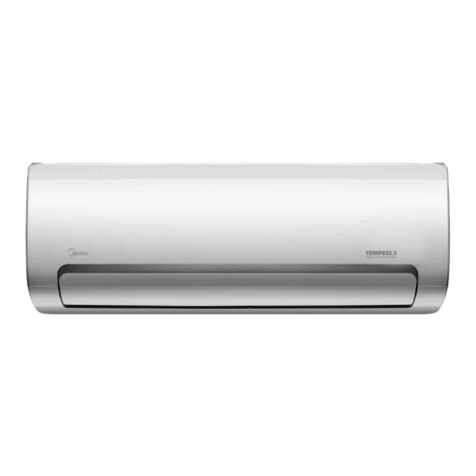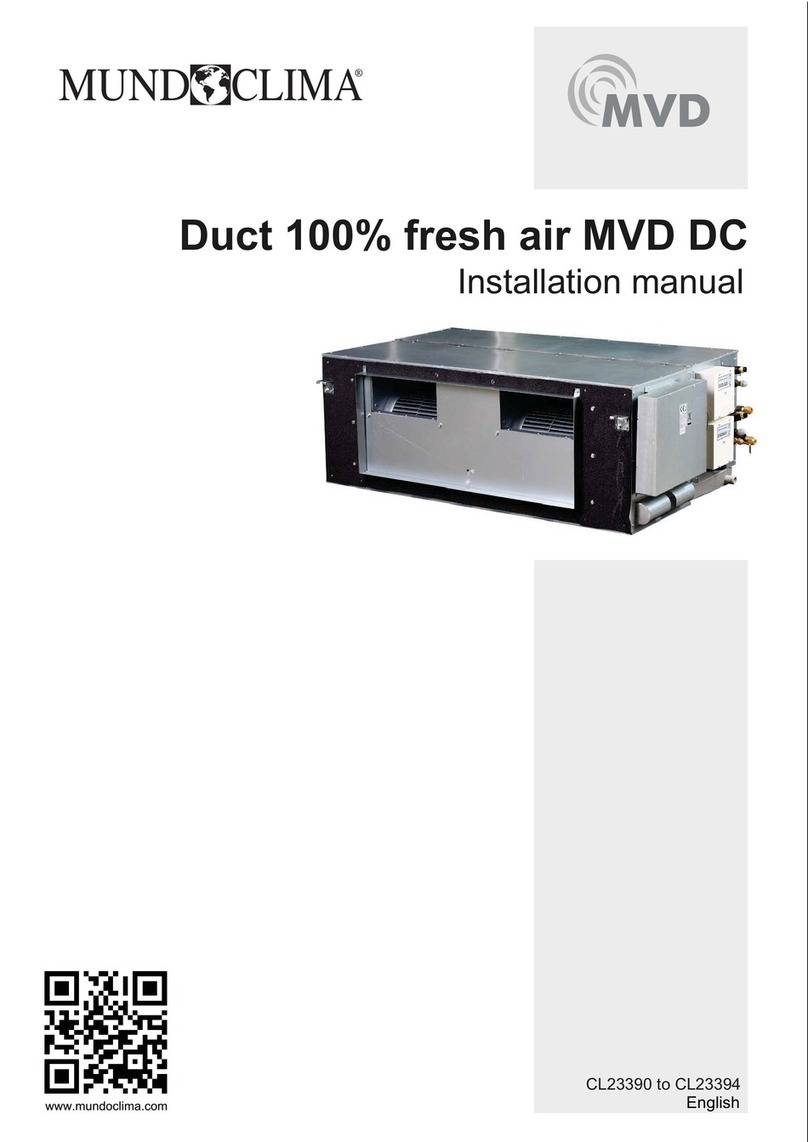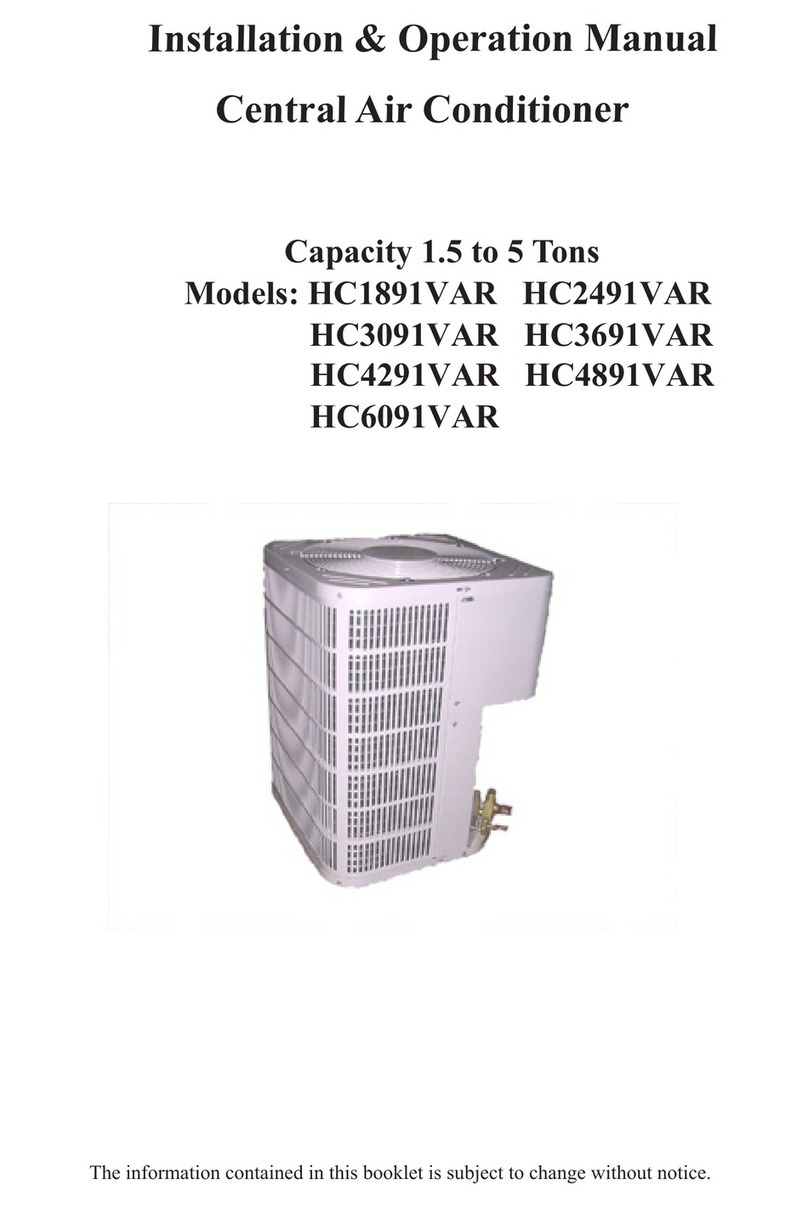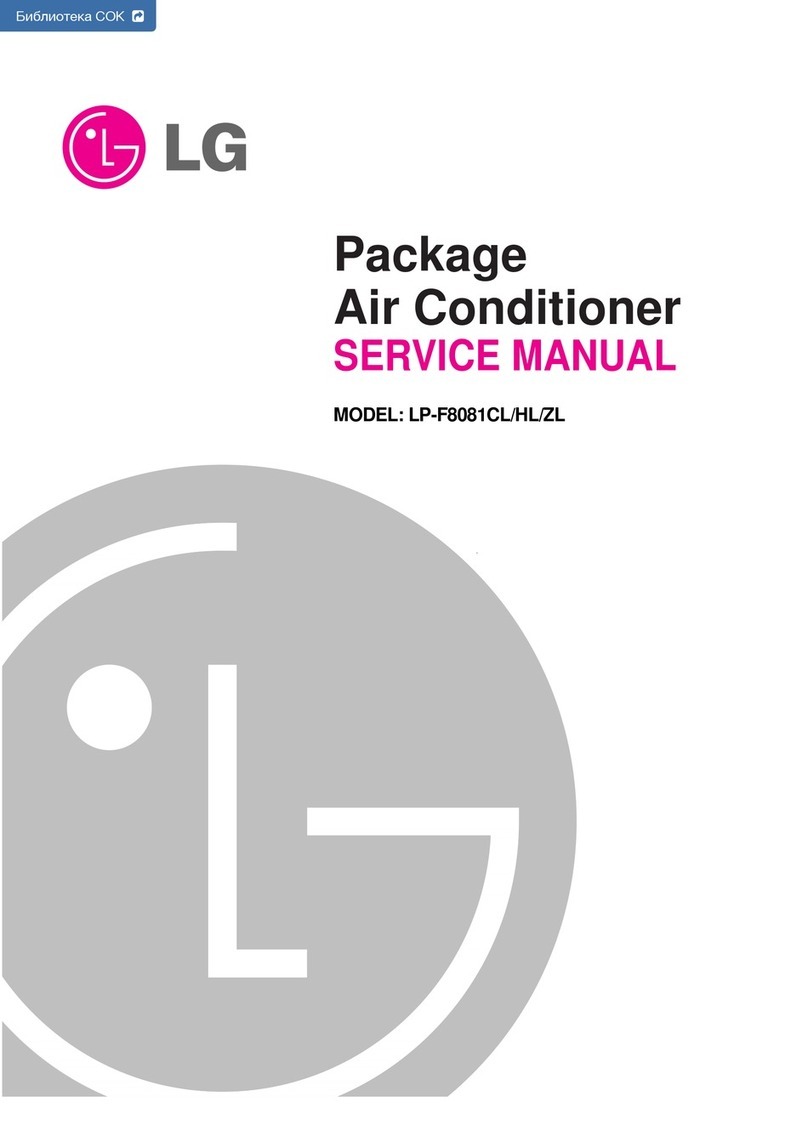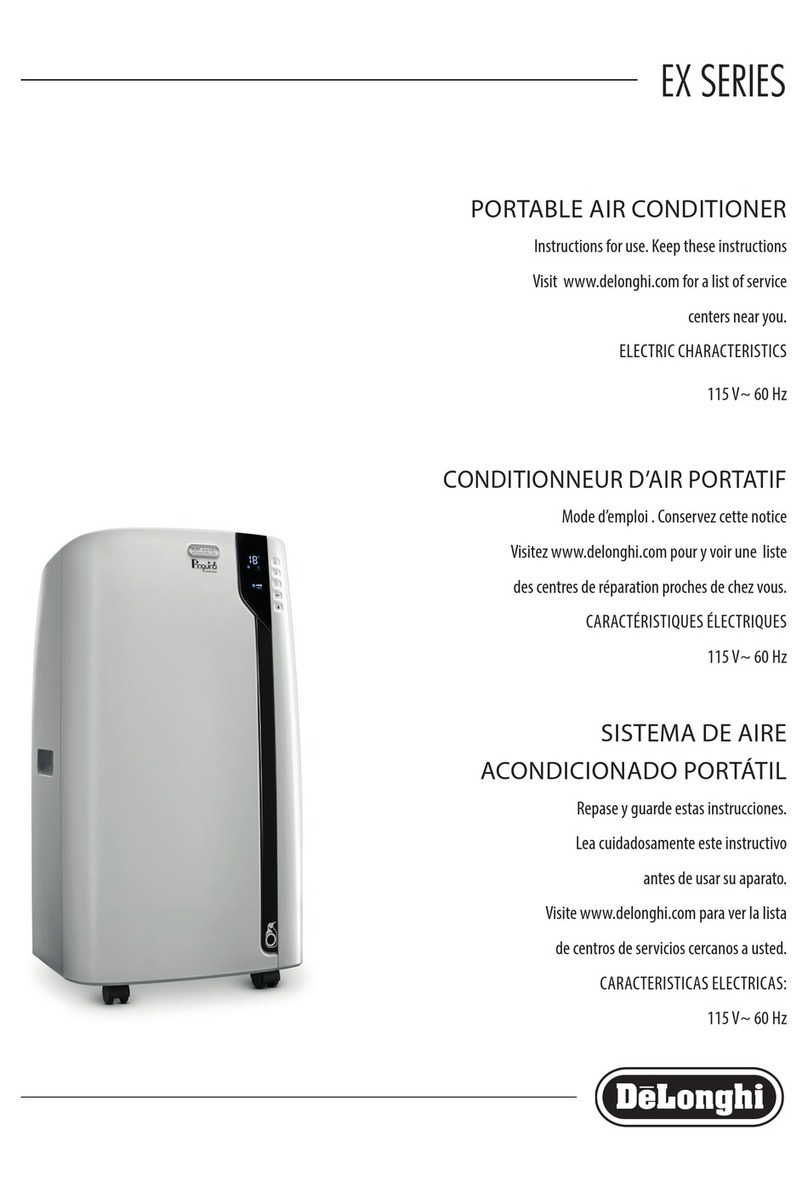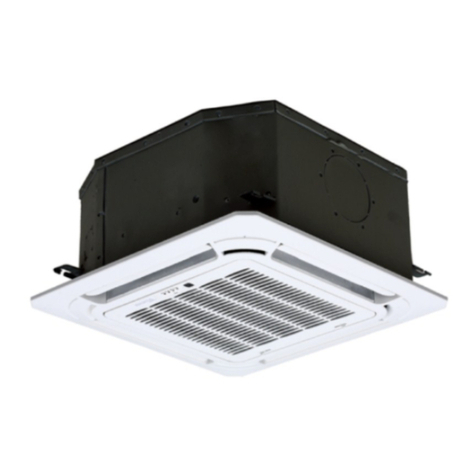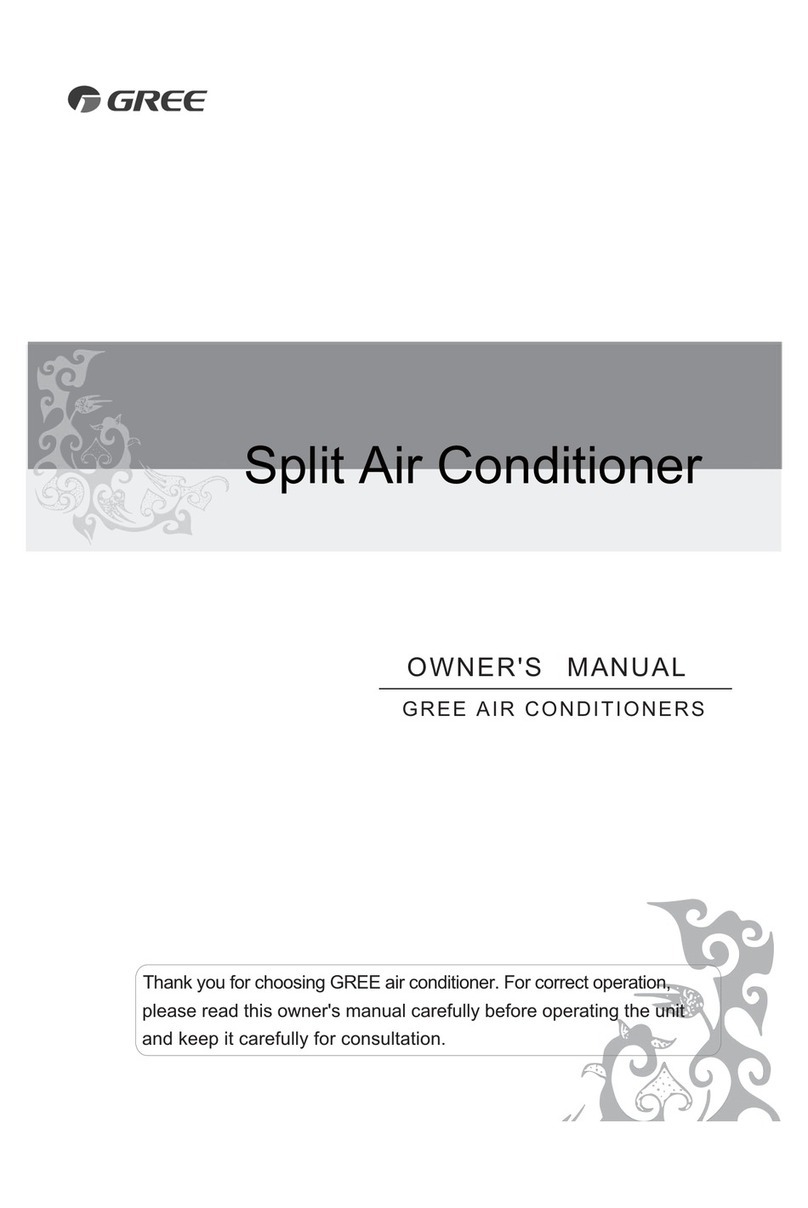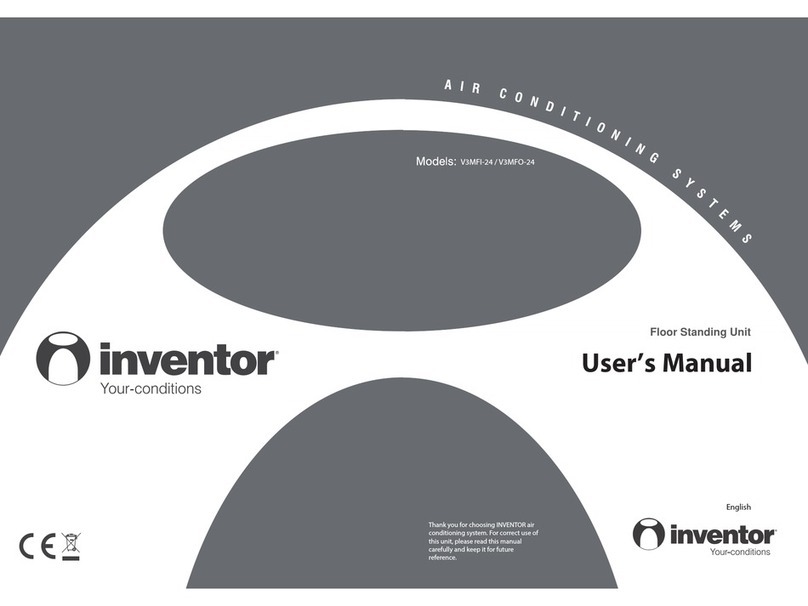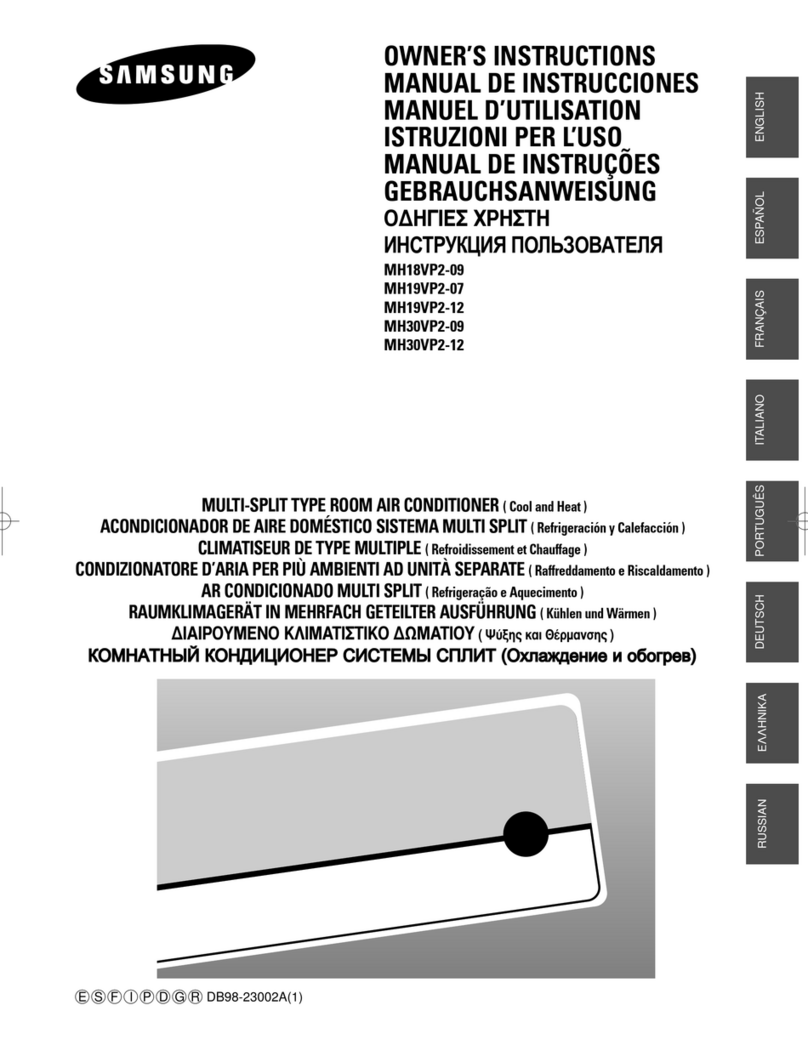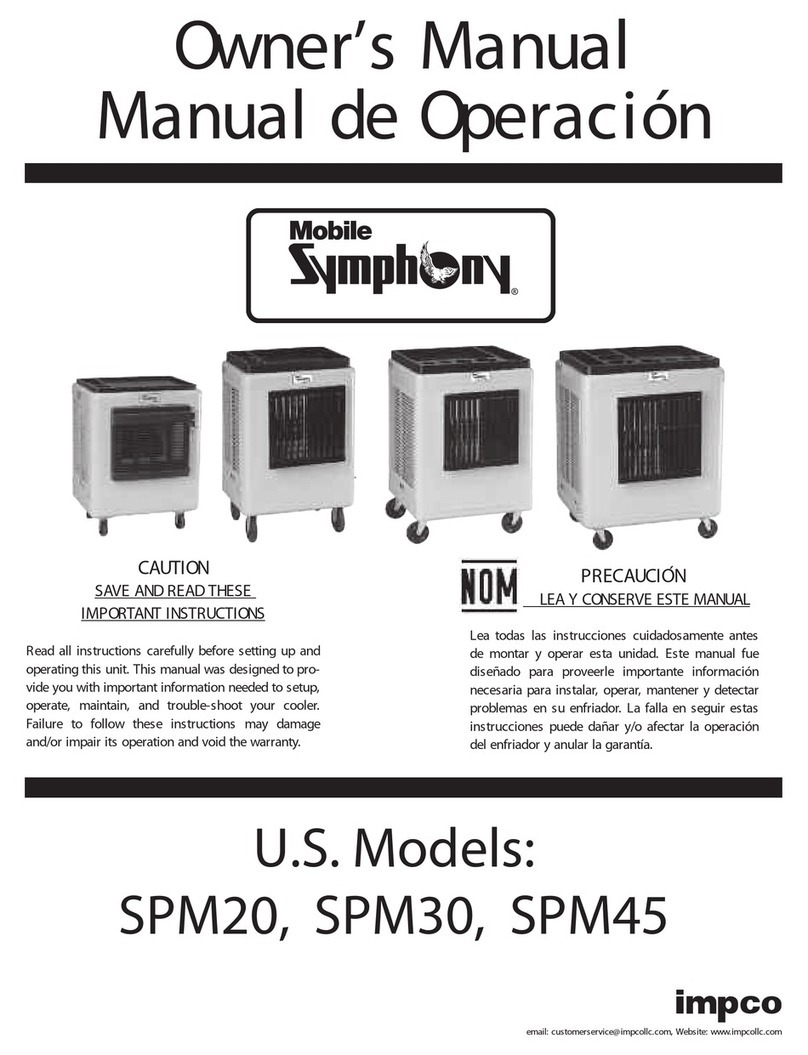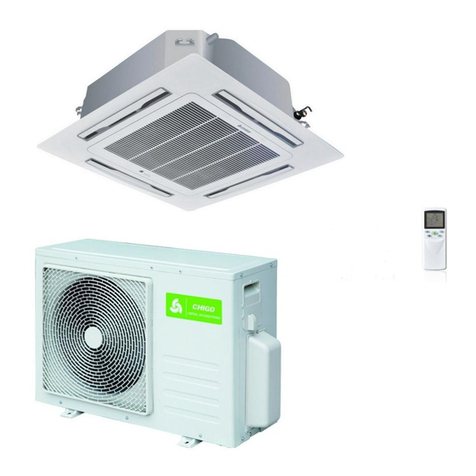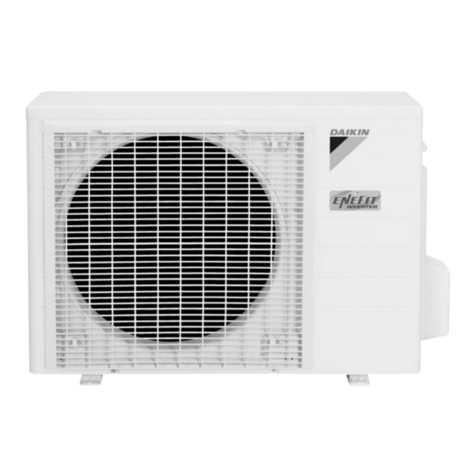CMNA DLCLRB Series User manual

Specifications subject to change without notice.
Fig. 1 —Size 36K
Fig. 2 —Size 48K
NOTES: Read the entire instruction manual before starting the
installation.
Images are for illustration purposes only. Actual
models may differ slightly.
TABLE OF CONTENTS
Page
SAFETY CONSIDERATIONS........................................................2
INTRODUCTION ............................................................................3
ACCESSORIES................................................................................3
DIMENSIONS..................................................................................4
CLEARANCES ................................................................................6
INSTALLATION REQUIREMENTS .............................................7
INSTALLATION .............................................................................7
Step 1 - Check Equipment ................................................................7
Step 2 - Mount Unit ..........................................................................7
Step 3 - Condensate Drain Installation .............................................8
Step 4 - Refrigerant Piping ...............................................................9
Step 5 - Evacuate Coil And Tubing System .....................................12
Step 6 - Electrical Connections.........................................................13
WIRING ...........................................................................................13
ELECTRICAL DATA......................................................................14
CONNECTION DIAGRAMS ..........................................................14
START-UP .......................................................................................15
CARE AND MAINTENANCE........................................................15
OUTDOOR UNIT DIAGNOSTIC GUIDES ...................................15
DUCTLESS START-UP CHECKLIST ...........................................16
DLCLRB
INSTALLATION INSTRUCTIONS
Outdoor Unit Single Zone Ductless System - Sizes 36 to 48

2 Specifications subject to change without notice. 32801100001
SAFETY CONSIDERATIONS
Installing, starting up, and servicing air- conditioning equipment
can be hazardous due to system pressures, electrical components,
and equipment location (roofs, elevated structures, etc.).
Only trained, qualified installers and service mechanics should
install, start- up, and service this equipment.
Untrained personnel can perform basic maintenance functions such
as coil cleaning. All other operations should be performed by
trained service personnel only.
When working on the equipment, observe the precautions in the
literature and on tags, stickers, and labels attached to the
equipment.
Follow all safety codes.Wear safety glasses and work gloves. Keep
a quenching cloth and a fire extinguisher nearby when brazing.
Use care in handling, rigging, and setting bulky equipment.
Read these instructions thoroughly and follow all warnings or
cautions included in literature and attached to the unit. Consult
local building codes and National Electrical Code (NEC) for
special requirements. Recognize safety information.
This is the safety- alert symbol . When you see this symbol on
the unit and in instructions or manuals, be alert to the potential for
personal injury. Understand these signal words: DANGER,
WARNING, and CAUTION. These words are used with the
safety- alert symbol. DANGER identifies the most serious hazards
which will result in severe personal injury or death. WA R N I N G
signifies hazards which could result in personal injury or death.
CAUTION is used to identify unsafe practices which may result in
minor personal injury or product and property damage.
NOTE is used to highlight suggestions which will result in
enhanced installation, reliability, or operation.
ELECTRICAL SHOCK HAZARD
Failure to follow this warning could result in personal injury or
death.
Before installing, modifying, or servicing system, main electrical
disconnect switch must be in the OFF position. There may be
more than 1 disconnect switch. Lock out and tag switch with a
suitable warning label.
WA R N I N G
EXPLOSION HAZARD
Failure to follow this warning could
result in death, serious personal injury,
and/or property damage.
Never use air or gases containing oxy-
gen for leak testing or operating refrig-
erant compressors. Pressurized
mixtures of air or gases containing oxy-
gen can lead to an explosion.
WA R N I N G
EQUIPMENT DAMAGE HAZARD
Failure to follow this caution may result in equipment damage or
improper operation.
Do not bury more than 36 in. (914 mm) of refrigerant pipe in the
ground. If any section of pipe is buried, there must be a 6 in. (152
mm) vertical rise to the valve connections on the outdoor units. If
more than the recommended length is buried, refrigerant may
migrate to the cooler buried section during extended periods of
system shutdown. This causes refrigerant slugging and could
possibly damage the compressor at start-up.
CAUTION

32801100001 Specifications subject to change without notice. 3
INTRODUCTION
The Horizontal Discharge Outdoor units are R-410A
condensing units designed with application flexibility in mind.
These units have a max total piping length up to 213 ft (65 m)
and a maximum piping lift of up to 98 ft (30m).
The inverter driven compressor is designed to run at various
input power frequencies (Hz) which controls the compressor’s
motor speed.
ACCESSORIES
The system is shipped with the following accessories. Use all
of the installation parts and accessories to install the system.
Improper installation may result in water leakage, electrical
shock and fire, or cause the equipment to fail. Keep the
installation manual in a safe place and do not discard any other
accessories until the installation work has been completed.
Table 1 —Accessories Fig. 3 —Parts List
NOTE:
- If the outdoor unit is higher than the indoor unit, prevent rain
from flowing into the indoor unit along the connection pipe by
making a downward arc in the connection pipe before it enters
the wall to the indoor unit. This ensures that rain drips from the
connection pipe before it enters the wall.
- Piping and the interconnecting wiring are field supplied.
- The illustration above is only a sketch. Different models may be
slightly different.
Table 2 lists the units covered in this manual.
Table 2 — Unit Sizes
PART
NO. PART NAME QTY.
1 Outdoor unit 1
-Literature package including installation instructions
and warranty 1
-Grommet to secure the outdoor unit (helps with
vibration prevention during unit operation) 4
-DrainJoint 1
-DrainHose 1
SYSTEM TONS KBTUH VOLTAGE -
PHASE OUTDOOR MODEL
3 36,000 208/230 - 1 DLCLRBH36AAK
4 48,000 208/230 - 1 DLCLRBH48AAK
Ŷ2XWGRRU

4 Specifications subject to change without notice. 32801100001
DIMENSIONS
Table 3 — Dimensions
Fig. 4 —Size 36K
UNIT SIZE 36K 48K
Height in (mm) 31.89 (810) 52.48 (1333)
Width in (mm) 37.24 (946) 37.48 (952)
Depth in (mm) 16.14 (410) 16.34 (415)
Operating Weight lbs (kg) 155.42 (70.5) 219.14 (99.4)
Shipping Weight lbs (kg) 166.23 (75.4) 249.12 (113)
Shipping Height in (mm) 34.45 (885) 34.45 (885)
Shipping Width in (mm) 42.91 (1090) 42.91 (1090)
Shipping Depth in (mm) 19.69 (500) 19.69 (500)

32801100001 Specifications subject to change without notice. 5
DIMENSIONS (CONT.)
Size 48K
Fig. 5 —Size 48K

6 Specifications subject to change without notice. 32801100001
CLEARANCES
Fig. 6 — Outdoor Unit Clearances
Table 4 — Outdoor Unit Clearance Dimensions
Fig. 7 —Clearances for multiple units
DB
AE
C
Air inlet
Air outlet
UNIT MINIMUM VALUE
IN. (MM)
A 24 (610)
B 24 (610)
C 24 (610)
D 4 (101)
E 4 (101)
59in (150cm)
or more when
facing each other
Blowing into the air-inlet of other
condenser shall be avoided.
24in (60cm)
or more
59in (150cm)
or more on a
multiple parallel
unit arrangement
24in (61cm) or more on a single parallel unit arrangement
19in (48cm) or more on
a multiple parallel unit
arrangement 4in (10cm)
or more on a single
parallel unit arrangement
9.8in (25cm) or more for proper airflow
24in (61cm) or more is recommended
for service
9.8in (25cm) or more for
proper airflow 24in (61cm)
or more is
recommended
for service

32801100001 Specifications subject to change without notice. 7
INSTALLATION REQUIREMENTS
• A location which is convenient to installation and not exposed to
strong winds.
• A location which can bear the weight of the outdoor unit and
where the outdoor unit can be mounted in a level position.
• A location which provides appropriate clearances (see Fig. 6).
• Do not install the indoor or outdoor units in a location with special
environmental conditions. For those applications, contact your
Sales representative.
• Allow sufficient space for airflow and service of the unit. See Fig.
6 — on page 7 for the required minimum distances between the
unit or walls.
NOTE: DO NOT install the indoor or outdoor units in a location with
special environmental conditions. For those applications, contact your
Ductless representative.
INSTALLATION
Step 1 - Check Equipment
Unpack the unit and move to the final location. Remove the carton,
taking care not to damage the unit. Inspect the equipment for damage
prior to installation. File a claim with the shipping company if the
shipment is damaged or incomplete.
Locate the unit rating plate which contains the proper installation
information. Check the rating plate to ensure the unit matches the job
specifications.
Step 2 - Mount Unit
1. Select the installation location of the outdoor unit following the
installation requirements. To prevent high wind exposure, install the
outdoor unit with the air inlet side facing the wall (see fig 8).
Fig. 8 — High Wind Installation
2. Use a rigid base to support the unit in a level position. If conditions
or local codes require the unit be attached to a pad, tie down bolts
should be used and fastened through knockouts provided in unit
base pan. Refer to unit mounting pattern in Fig. 3 to determine base
pan size and knockout hole location. For hurricane tie downs,
contact distributor for details and PE (Professional Engineer)
Certification, if required. For extreme outdoor conditions
applications refer to the 'Cold Climate Application Guideline
Ductless’.
PRODUCT INSTALLATION
• Installation must be performed by an authorized dealer or
specialist. A defective installation can cause water leakage,
electrical shock, or fire.
• The installation must be performed according to the installation
instructions. Improper installation can cause water leakage,
electrical shock, or fire. (In North America, installation must be
performed in accordance with the requirements of NEC or CEC
by authorized personnel only.)
• Contact an authorized service technician for repair or
maintenance of this unit. This appliance must be installed in
accordance with local codes.
• Only use the included accessories, parts, and specified parts for
installation. Using non-standard parts can cause water leakage,
electrical shock, fire, or unit failure.
• Install drainage piping according to the instructions in this
manual. Improper drainage may cause water damage to your
home and property.
•DO NOT install the unit in a location that may be exposed to
combustible gas leaks. If combustible gas accumulates around
the unit, it may cause a fire.
•DO NOT turn on the power until all work has been completed.
• When moving or relocating the system, consult experienced
service technicians for the disconnection and re-installation of
the unit.
WA R N I N G
Strong
wind
EQUIPMENT DAMAGE HAZARD
Failure to follow this caution may result in equipment damage or
improper operation.
In regions with snowfall and cold temperatures, avoid installing
the outdoor unit in areas where it can be covered by snow.
Blocking the air intake may result in reduced airflow,
significantly reduced performance and damage to the equipment.
CAUTION

8 Specifications subject to change without notice. 32801100001
Step 3 - Condensate Drain Installation
Install drains must meet local sanitation codes.
Install the outdoor unit drain joint
Fit the seal into the drain joint, then insert the drain joint into the base
pan hole of the outdoor unit. Rotate 90° to securely assemble them.
Connect the drain joint with an extension drain hose to avoid
condensate from draining off the outdoor unit during the heating
mode.
Fig. 9 —Drain Joint
NOTE: Images are for illustration purposes only.
NOTE: Basepan built-in with multiple holes for proper
draining during defrost. For applications where it is
required to seal these holes, and re-direct the
condensate drain, rubber plugs are available through
RCD.
Table 5 — Base Pan Base Rubber Plugs
Seal Base pan hole
Drain joint
Seal
Base pan Drain
joint
OUTDOOR UNIT
MODEL NUMBER
PER UNIT
BASE PAN BASE
RUBBER PLUGS RCD
PART NUMBER
QUANTITY
DLCLRBH36AAK 12600801A00117 5
DLCLRBH48AAK 12600801A00118 5
EQUIPMENT DAMAGE HAZARD
In cold climates, ensure the drain hose is as vertical as possible to
ensure swift water drainage. If water drains too slowly, it can freeze
in the hose and flood the unit.
CAUTION

32801100001 Specifications subject to change without notice. 9
Step 4 - Refrigerant Piping
Table 6 — Piping and Refrigerant Information
IMPORTANT: Both refrigerant lines must be insulated
separately. Use refrigeration grade tubing ONLY. No other
type of tubing may be used. Use of other types of tubing
will void the manufacturer's warranty.
• All outdoor units have an electronic expansion valve to manage the
refrigerant flow of the fan coil connected.
• The minimum refrigerant line length between the indoor and
outdoor unit is 10 ft. (3m).
• When paired with Ductless indoor units, size the line sets based on
the connection size of the indoor unit unless specified.
• Do not open the service valves or remove the protective caps from
the tubing ends until all connections are made.
• Bend the tubing with bending tools to avoid kinks and flat spots.
• Keep the tubing free of dirt, sand, moisture, and other
contaminants to avoid damaging the refrigerant system.
• Avoid sags in the suction line to prevent the formation of oil traps.
• Insulate each tube with a minimum 3/8-in. (10 mm) wall thermal
pipe insulation. Inserting the tubing into the insulation before
making the connections will save time and improve installation
quality.
SYSTEM SIZE 36K 48K
Piping
Min. Piping Length ft (m) 10 (3) 10 (3)
Standard Piping Length ft (m) 25 (7.5) 25 (7.5)
Max. outdoor - indoor height difference (OU higher than IU) ft (m) 98 (30) 98 (30)
Max. outdoor - indoor height difference (IU higher than OU) ft (m) 98 (30) 98 (30)
Max. Piping length with no additional refrigerant charge ft (m) 25 (7.5) 25 (7.5)
Max. Piping Length ft (m) 213 (65) 213 (65)
Additional refrigerant charge (between Standard - Max piping length) Oz/ ft (g/m) 0.32 (30) 0.32 (30)
Gas Pipe (size - connection type) in (mm) 5/8 (16) 5/8 (16)
Liquid Pipe (size- connection type) in (mm) 3/8 (9.52) 3/8 (9.52)
Refrigerant Refrigerant Type - - R410A R410A
Charge Amount Lbs (kg) 7.05 (3.2) 9.92 (4.5)
All field piping must be completed by a licensed technician and
must comply with the local and national regulations.
When the system is installed in a small room, measures must be
taken to prevent the refrigerant concentration in the room from
exceeding the safety limit in the event of refrigerant leakage. If the
refrigerant leaks and its concentration exceeds its proper limit,
hazards due to lack of oxygen may result.
When installing the refrigeration system, ensure that air, dust,
moisture or foreign substances do not enter the refrigerant circuit.
Contamination in the system may cause poor operating capacity,
high pressure in the refrigeration cycle, explosion or injury.
Ventilate the area immediately if there is refrigerant leakage
during the installation.
Leaked refrigerant gas is hazardous. Ensure there is no refrigerant
leakage after completing the installation work.
WA R N I N G
DO NOT install the connecting pipe until both the indoor and
outdoor units have been installed.
Insulate both the gas and liquid piping to prevent condensation.
CAUTION

10 Specifications subject to change without notice. 32801100001
Use the following steps to connect the refrigerant piping:
1. Run the interconnecting piping from the outdoor unit to the indoor
unit.
2. Connect the refrigerant piping and drain line outside the indoor
unit. Complete the pipe insulation at the flare connection then
fasten the piping and wiring to the wall as required. Completely seal
the hole in the wall.
3. Cut tubing to the correct length.
When preparing refrigerant pipes, take extra care to cut and
flare them properly. This ensures efficient operation and
minimizes the need for future maintenance.
a. Measure the distance between the indoor and outdoor units.
b. Using a pipe cutter, cut the pipe a little longer than the
measured distance.
c. Make sure the pipe is cut at a perfect 90° angle.
Fig. 10 — Pipe Cutting
4. Remove Burrs
Burrs can affect the air-tight seal of the refrigerant piping connection.
Therefore, they must be completely removed. To remove:
a. Hold the pipe at a downward angle to prevent burrs from
falling into the pipe.
b. Using a reamer or deburring tool, remove all burrs from the
cut section of the pipe.
Fig. 11 — Deburring Tool
5. Flare Pipe Ends
Proper flaring is essential to achieving an airtight seal.
a. After removing the burrs from the cut pipe, seal the ends with
PVC tape to prevent foreign materials from entering the pipe.
b. Sheath the pipe with insulating material.
c. Place factory flare nut on pipe facing the proper direction.
Make sure they are facing the right direction. Once the ends are
flared, it is impossible to put them on or change their direction.
Fig. 12 — Copper pipe and flare nut
d. Remove the PVC tape from ends of pipe when ready to perform
the flaring work.
e. Clamp the flare block on the end of the pipe. The end of the
pipe must extend beyond the flare form.
Fig. 13 — Flare Block
f. Place the flaring tool onto the form.
g. Turn the handle of the flaring tool clockwise until the pipe is fully
flared. Flare the pipe in accordance with the dimensions in Table 7.
Fig. 14 — Flare Shape
Table 7 — Flare Nut Spacing
h. Remove the flaring tool and flare block, then inspect the end
of the pipe for cracks and even flaring.
Oblique Rough
Warped
90°
DO NOT DEFORM PIPE WHILE CUTTING
Be extra careful not to damage, dent, or deform the pipe while
cutting. This will drastically reduce the heating efficiency of the unit.
CAUTION
Pipe
Reamer
Point down
OUTER DIAMETER
IN (MM)
A” IN (MM)
MAX. MIN.
Ø 1/4” (6.35) 0.05 (1.3) 0.03 (0.7)
Ø 3/8” (9.52) 0.06 (1.6) 0.04 (1.0)
Ø 1/2” (12.7) 0.07 (1.8) 0.04 (1.0)
Ø 5/8” (15.88) 0.09 (2.2) 0.08 (2.0)
Flare nut
Copper pipe
Flare block
Pipe
R0.4~0.8
45qr2
90 q
r4
A

32801100001 Specifications subject to change without notice. 11
6. Connect the Pipes
Connect the copper pipes to the indoor unit first, then connect
the pipes to the outdoor unit. Connect the low-pressure pipe
first, then connect the high pressure pipe.
a. When connecting the flare nuts, apply a thin coat of
refrigeration oil to the flared ends of the pipes.
b. Align the center of the two pipes that you will connect.
Fig. 15 — Align the center of the two pipes
c. Tighten the flare nut as much as possible by hand.
d. Using a wrench, grip the nut on the unit tubing.
e. While firmly gripping the nut, use a torque wrench to
tighten the flare nut according to the torque values listed in
Table 8.
Table 8 — Tightening Torque
NOTE: Use both a backup wrench and a torque wrench when
connecting or disconnecting pipes to or from the unit.
Fig. 16 — Torque wrench with backup wrench
All tubing bends should be performed with a properly sized tubing
bender to prevent kinking or damaging the tubing.
f. After connecting the copper pipes to the indoor unit, wrap
the power cable, signal cable and the piping together with
binding tape.
NOTE: While bundling these items together, DO NOT intertwine or
cross the signal cable with any other wiring.
g. Thread this lineset through the wall and connect it to the
outdoor unit.
h. Insulate all piping, including the outdoor unit valves.
NOTE: DO NOT open the service valves until pressure test is
complete.
7. Pressure Test Piping
NOTE: Use refrigeration gauges that are pressure rated for
R410a refrigerant.
a. Attach low side gauge hose to the 5/16” Schrader valve on
the outdoor unit service valve.
b. Attach the charging hose to the regulator on the dry nitrogen
tank.
c. Preset the nitrogen regulator to 550 psi.
d. Slowly pressurize the line set until the low side gauge reads
500 psi. Do not exceed 550 psi.
e. Close all the valves on the nitrogen tank and gauges.
f. Allow the pressure test to stand for a minimum of 30
minutes.
g. If the pressure holds, release the nitrogen and proceed with
See “Step 5 - Evacuate Coil And Tubing System” on
page 12..
h. If the pressure goes down in the 30 minute delay, leak check
the tubing and flare fittings to identify the source of the
leak. Return to Step C, above.
BRASS FLARE SIZE
(IN”)
RECOMMENDED SEATING
TORQUE FOR BRASS
FLARE NUTS
N-M
Ø1/4 8-10 Ft. - Lbs. 10.8 to 13.6
Ø3/8 15-18 Ft. - Lbs 20.3 to 24.4
Ø1/2 28-32 Ft. - Lbs 38.0 to 43.4
Ø5/8 38-42 Ft. - Lbs 51.5 to 56.9
Ø3/4 50-55 Ft. - Lbs. 68.0 to 74.6
Pipe
Indoor unit tubing Flare nut
Wrap insulation around the piping. Direct contact with the bare
piping may result in burns or frostbite. Ensure the pipe is properly
connected. Over tightening may damage the bell mouth and under
tightening may lead to leakage.
CAUTION
Only use Dry Nitrogen to pressure test refrigerant systems. Use of
other gases can result in injury, property damage or death.
CAUTION

12 Specifications subject to change without notice. 32801100001
Step 5 - Evacuate Coil And Tubing System
Refrigerant tubes and the indoor coil should be evacuated using the
recommended 500 microns deep vacuum method. The alternate triple
evacuation method may be used if the procedure outlined below is
followed.
NOTE: Always break a vacuum with dry nitrogen.
Using Vacuum Pump
1. Completely tighten flare nuts A, B, C, D. Connect the manifold
gage charge hose to a charge port of the low side service valve (see
Fig. 17).
2. Connect the charge hose to vacuum pump.
3. Fully open the low side of manifold gage (see Fig. 18).
4. Start the vacuum pump.
5. Evacuate using either the deep vacuum or triple evacuation method.
6. After evacuation is complete, fully close the low side of manifold
gage and stop the vacuum pump operation.
7. The factory charge contained in the outdoor unit is good for up to
25 ft. (8 m) of line length. For refrigerant lines longer than 25 ft. (8
m), add refrigerant, up to the allowable length.
8. Disconnect the charge hose from the charge connection of the low
side service valve.
9. Fully open service valves B and A.
10. Securely tighten the service valve caps.
Fig. 17 — Service Valve
Fig. 18 — Manifold
Evacuation
Evacuation of the system will remove air or nitrogen (non-condensables)
as well as moisture. A proper vacuum will assure a tight, dry system
before charging with refrigerant. The two methods used to evacuate a
system are the deep vacuum method and the triple vacuum method.
Deep Vacuum Method
The deep vacuum method requires a vacuum pump capable of pulling
a vacuum of 500 microns and a vacuum gauge capable of accurately
measuring this vacuum depth. The deep vacuum method is the most
positive way of assuring a system is free of air and moisture (see
Figure 19).
Fig. 19 — Deep Vacuum Graph
Triple Evacuation Method
The triple evacuation method should be used when vacuum pump
is not capable of pumping down to 500 microns and system does not
contain any liquid water. Refer to Fig. 20 and proceed as follows:
1. Attach refrigeration gauges and evacuate system down to 28 in. of
mercury and allow pump to continue operating for an additional 15
minutes.
2. Close service valves and shut off vacuum pump.
3. Connect a nitrogen cylinder and regulator to system and flow
nitrogen until system pressure is 2 psig.
4. Close service valve and allow system to stand for 1 hour. During
this time, dry nitrogen will be able to diffuse throughout the system
absorbing moisture.
5. Repeat this procedure as indicated in Fig. 20. System will then be
free of any contaminants and water vapor.
Fig. 20 — Triple Evacuation Method
Final Tubing Check
Check to be certain factory tubing on both the indoor and outdoor unit
has not shifted during shipment. Ensure tubes are not rubbing against
each other or any sheet metal. Pay close attention to the feeder tubes,
making sure wire ties on feeder tubes are secure and tight.
UNIT DAMAGE HAZARD
Failure to follow this caution may result in equipment damage or
improper operation.
Never use the system compressor as a vacuum pump.
CAUTION
Outdoor Unit Indoor UnitRefrigerant
Service Valve
Low Side
High Side
A
B
C
D
500 microns
Low side valve
High side valve
Charge hose
Charge hose
Vacuum
pump
Low side valve
500
MINUTES
01234567
1000
1500
LEAK IN
SYSTEM
SYSTEM TIGHT
EVACUATE MOISTURE
TIGHT DRY SYSTEM
2000
MICRONS
2500
3000
3500
4000
4500
5000
CHECK FOR TIGHT, DRY SYSTEM
(IF IT HOLDS DEEP VACUUM)
EVACUATE
BREAK VACUUM WITH DRY NITROGEN
WAIT
EVACUATE
RELEASE CHARGE INTO SYSTEM
BREAK VACUUM WITH DRY NITROGEN
EVACUATE
WAIT

32801100001 Specifications subject to change without notice. 13
Step 6 - Electrical Connections
Install All Power and Interconnecting Wiring to
Outdoor Units
1. Mount the outdoor power disconnect.
2. Run the power wiring from the main box to disconnect per NEC
and local codes.
3. Remove the field wiring cover from the unit by loosening the
screws.
4. Remove the caps on the conduit panel.
5. Connect the conduit to conduit panel (see Fig.21).
6. Properly connect both the power supply and control lines to the
terminal block per the connection diagram for the appropriate unit
capacity and voltage.
7. Ground the unit in accordance with NEC and local electrical codes.
8. Use the lock nuts to secure the conduit.
9. Reinstall the field wiring cover.
Fig. 21 —Field Wiring
WIRING
All wires must be sized per NEC (National Electrical Code) or CEC
(Canadian Electrical Code) and local codes. Use Electrical Data table MCA
(minimum circuit amps) and MOCP (maximum over current protection) to
correctly size the wires and the disconnect fuse or breakers respectively.
SIZES 36-48 RECOMMENDED CONNECTION METHOD
FOR POWER AND COMMUNICATION WIRING
Power and Communication Wiring: The main power is supplied to
the outdoor unit. The field supplied power wiring from the outdoor
unit to the indoor unit consists of three (3) wires and provides the
power for the indoor unit. Two wires are high voltage AC power and
one is a ground wire. To minimize voltage drop, the factory
recommended wire size is 14/2 stranded with a ground.
Communication Wiring: A separate shielded stranded copper
conductor only, with a 600 volt rating and double insulated copper
wire, must be used as the communication wire from the outdoor unit
to the indoor unit.
Please use a separate shielded 16GA stranded control wire.
Table 9 — Wiring Sizes 36-48
EQUIPMENT DAMAGE HAZARD
Failure to follow this caution may result in equipment damage or
improper operation.
Be sure to comply with local codes while running wire from
indoor unit to outdoor unit.
Every wire must be connected firmly. Loose wiring may cause the
terminal to overheat or result in unit malfunction. A fire hazard
may also exist. Therefore, ensure all wiring is tightly connected.
No wire should be allowed to touch the refrigerant tubing,
compressor or any moving parts.
Disconnecting means must be provided and shall be located within
sight and readily accessible from the air conditioner.
Connecting cable with the conduit shall be routed through hole in
the conduit panel.
CAUTION
Over 1.57" (40mm)
Terminal Block
Conduit
panel
Conduit
Outdoor unit
CABLE CABLE SIZE REMARKS
Power
Connection Cable 14AWG 2 wire + Ground 1Φ208/230 V
Communication
Cable 16AWG 2 wire stranded shielded
control wire
EQUIPMENT DAMAGE HAZARD
Failure to follow this caution may result in equipment damage or
improper operation. Wires should be sized based on NEDC and
local codes.
WARNING
EQUIPMENT DAMAGE HAZARD
Failure to follow this caution may result in equipment damage or
improper operation. Be sure to comply with local codes while
running wire from the indoor unit to the outdoor unit. Every wire
must be connected firmly. Loose wiring may cause the terminal to
overheat or result in unit malfunction. A fire hazard may also exist.
Ensure all wiring is tightly connected.
No wire should touch the refrigerant tubing, compressor or any
moving parts. Disconnecting means must be provided and shall be
located within sight and readily accessible from the air conditioner.
Connecting cable with conduit shall be routed through the hole in
the conduit panel.
CAUTION

14 Specifications subject to change without notice. 32801100001
ELECTRICAL DATA
Table 10 — Electrical Data
*Permissible limits of the voltage range at which the unit will operate satisfactorily.
LEGEND
FLA - Full Load Amps
MCA - Minimum Circuit Amps
MOCP - Maximum Over-Current Protection
RLA - Rated Load Amps
CONNECTION DIAGRAMS
Fig. 22 — Connection Diagram sizes 36-48
Fig. 23 — Control and Power Terminals on Indoor Unit sizes 36-48
NOTES:
1. Do not use the thermostat wire for any connection between indoor and outdoor units.
2. All connections between indoor and outdoor units must be as shown in Figure 22. The connections are sensitive to polarity and will result in a
fault code.
OUTDOOR UNIT SIZE 36K 48K
Power Supply
208/230 - 1 - 60 208/230 - 1 - 60
Max – Min* Oper. Voltage 253 - 187 253 - 187
MCA 30 36.5
MOCP 45 50
Compressor Volts- PH- Hz 208/230 - 1 - 60 208/230 - 1 - 60
RLA 23.5 28
Outdoor Fan Motor
FLA 0.6 1.17
Rated HP 0.16 0.11
Output 120 85
208-230-1-60
L1 L2
FIELD POWER SUPPLY
Indoor Unit
Power Supply
Low voltage
Nonpolar RS-485
communication
208-230-1-60
Nonpolar RS-485
Low voltage
communication
Outdoor Unit
208-230-1-60
Power Supply
SHIELDED WIRE CONNECTING
OUTDOOR TO INDOOR
To Indoor Unit
Power Supply
S1 S2
L1
(1)L1 (2)L2
L2
P(S1)
GND
Q(S2)
CONNECTING CABLE
OUTDOOR TO INDOOR

32801100001 Specifications subject to change without notice. 15
START-UP
Test Operation
Perform a test operation after completing a gas leak and electrical safety check. See the indoor unit installation instructions and owner's manual
for additional start up information.
System Checks
1. Conceal the tubing where possible.
2. Make sure that the drain tube slopes downward along its entire length.
3. Ensure all tubing and connections are properly insulated.
4. Fasten the tubes to the outside wall, when possible.
5. Seal the hole through which the cables and tubing pass.
Outdoor Unit
Are there unusual noises or vibrations during operation?
Explain the Following Item to the Customer (with the aid of the Owner's Manual):
• Explain unit care and maintenance.
IMPORTANT: Present the installation instructions to the customer.
CARE AND MAINTENANCE
To help ensure high performance and minimize possible equipment failure, periodic maintenance must be performed on this equipment.
Maintenance frequency may vary depending upon geographic areas.
OUTDOOR UNIT DIAGNOSTIC GUIDES
For ease of service, the systems are equipped with a diagnostic code display LEDs on both the indoor and outdoor units. The outdoor diagnostic
is displayed on the outdoor unit microprocessor board.
There may be a few error codes displayed in the indoor unit that might relate to the outdoor unit's problems. If possible, always check the
diagnostic codes displayed on the indoor unit first.
The diagnostic codes displayed on the outdoor units are listed on Table 11.
Table 11 — Unit Diagnostic Guides
For additional diagnostic information, refer to the service manual.
DISPLAY LED STATUS
E1 Communication malfunction between indoor and outdoor units.
F0 Protection of over - current
F1 Open circuit or short circuit of outdoor ambient temperature sensor T4
F2 Open circuit or short circuit of condenser coil temperature sensor T3
F3 Open circuit or short circuit of Compressor discharge temperature sensor T5
F4 Outdoor unit EEPROM error
F5 Outdoor fan speed has been out of control
P0 IPM malfunction
P1 Over voltage or over low voltage protection
P2 High temperature protection of compressor top
P3 Outdoor low temperature protection
P4 Inverter compressor drive error
P7 Outdoor IGBT temperature sensor error
J0 High temperature protection of indoor coil in heating
J1 Outdoor temperature protection of outdoor coil in cooling
J2 Discharge temperature protection
J3 Protection of active PFC module
J4 Communication error between control board and IPM board
J5 High - pressure switch protection
J6 Low - pressure switch protection
J8 AC voltage protection

16 Specifications subject to change without notice. 32801100001
Installation Data
Site Address:_______________________________________________________________________________________________________
City:________________________________________________________ State:___________ Zip Code:__________________
Installing Contractor:______________________________________________________ Contractor Contact #: ( ) _____-___________
Job Name:_______________________________________________________________ Start-up Date:_____________________________
Distributor:_______________________________________________________________
System Details
Wiring Electrical
Wire Size and Type Used? AWG:__________ TYPE:_________
Are there any breaks, splices, wire nuts or butt connectors between the outdoor unit and the indoor door unit? YES:______ NO:______
Was the wiring from the outdoor unit port to the correct indoor unit verified? YES:______ NO:______
REMARKS:_______________________________________________________________________________________________________
__________________________________________________________________________________________________________________
Voltage Check
Wiring: Single zone ___________
UNITS MODEL NO. SERIAL NO. CONTROLLER
OUTDOOR UNIT
INDOOR UNIT A
Outdoor Unit
Disconnect
1(L1):GND
Outdoor Unit
Terminal Block
1(L1):GND NOTES:__________________________________
_________________________________________
_________________________________________
_________________________________________
_________________________________________
2(L2):GND 2(L2):GND
1(L1):L2(2) 1(L1):2(L2)
Indoor Unit
Voltage Check
@ Outdoor Unit
1(L1):GND
Indoor Unit
Voltage Check
@ Indoor Unit
1(L1):GND NOTES:__________________________________
_________________________________________
_________________________________________
_________________________________________
_________________________________________
2(L2):GND 2(L2):GND
1(L1):2(L2) 1(L1):2(L2)
2(L2):3(S) 2(L2):3(S)
DUCTLESS START-UP CHECKLIST

32801100001 Specifications subject to change without notice. 17
Ductless Start-Up Checklist (CONT)
Piping
Leak Check:
System held 500 psig (max. 550psi) for a minimum of 30 minutes using dry nitrogen. YES:______ NO:______
Evacuation Method:
•Was the Triple Evacuation Method used as outlined in the installation manual? YES:______ NO:______
• Was the Deep Vacuum Method used as outlined in the installation manual? YES:______ NO:_______
• Did the System Hold 500 microns for 1 hour? YES:______ NO:_______
• Does the line set match the diameter of the evaporator connections? YES:______ NO:_______
Single Zone Piping:
Has the liquid pipe length been measured and the additional charge calculated? Size:___________ Length:_________ Charge:____________
Performance Check
Error Codes
Were there any error codes present at start-up? YES:______ NO:______
Comments:
__________________________________________________________________________________________________________________
__________________________________________________________________________________________________________________
__________________________________________________________________________________________________________________
NOTES:
PORT LIQUID SIZE SUCTION SIZE LENGTH CHARGE NOTES:____________________________________
___________________________________________
___________________________________________
A
For 1:1 Single Zone Systems: Adjust the set-point to create an operational call for the desired testing operation. Allow the system to run for a
minimum of 10 min. and record the following details:
(Operational data recorded on applicable heads with the wireless remote controller’s Point Check function)
UNIT
SET-POINT
MODE T1 T2 T3 T4 Tb Tp Th LA/Lr
A
Indoor Unit Error Code: Notes:
Outdoor Unit Error Code:
Wall Controller:
24V Interface:

Copyright 2020 CMNA
3300 Riverwood Parkway Atlanta GA 30339 32801100001
This manual suits for next models
2
Table of contents
Other CMNA Air Conditioner manuals
